Antiradical and Antioxidant Activity and Stimulation of Pancreatic Lipase by Extracts Obtained from Saponin-Rich Raw Materials: Experimental and In Silico Study
Abstract
1. Introduction
2. Results
2.1. Influence of Extracts on Lipase Activity
2.2. The Amount of General Phenolic Compounds and Flavonoids in Extracts
2.3. Antioxidant and Antiradical Potential of Extracts
2.4. Equilibrium Surface Tension, Surface Elasticity Modulus, and Surface Viscosity Modulus
2.5. Emulsion Stability in the Presence of Extracts
2.6. Qualitative Analysis of Compounds in the Most Active Extracts by UHPLC
2.7. In Silico Study of Emulsion Stabilization
2.8. The Effect of Saponins on the Lipolytic Activity of Pancreatic Lipase Through Computational Studies
3. Discussion
4. Materials and Methods
4.1. Raw Materials
| Botanical Name of Species | English Common Name | Plant Part English (Latin) | Abbreviation for Extract Used Herein | Weight of Extract [g] |
| Ruscus aculeatus | Butcher’s broom | Rhizome (rhizoma) | R.a. | 2.05 |
| Quillaja saponaria | Soap bark tree | Bark (cortex) | Q.s. | 1.60 |
| Gypsophila paniculata | Common gypsophila | Root (radix) | G.p. | 1.99 |
| Panax ginseng | Ginseng | Root (radix) | P.g. | 2.05 |
| Glycyrrhiza glabra | Licorice | Root (radix) | G.g. | 1.87 |
| Primula veris | Cowslip (Oxlip) | Root (radix) | P.v. | 1.97 |
| Hedera helix | Ivy | Leaf (folium) | H.h. | 1.87 |
| Aesculus hippocastanum | Horse chestnut | Seed (semen) | A.h. | 1.72 |
| Trigonella foenum-graecum | Fenugreek | Seed (semen) | T.f.g. | 1.85 |
4.2. Reagents
4.3. Apparatus
- Vacuum evaporator Buchi (Buchi, Rotavapor R-100, Flawil, Switzerland);
- Laboratory scales (Radwag, AS 82/220, Radom, Poland);
- Lyophilizer (Christ Alpha 1-2 LO Plus, Frankfurt, Germany);
- Water bath with precise temperature control, (AJL, LW 102, Kraków, Poland);
- pH meter (Oakton, WD-35419-03, Vernon Hills, IL, USA);
- Laboratory water purification unit Integral 10 Milli-Q (Millipore, Burlington, VT, USA);
- Profile Analysis Tensiometer PAT-1 (Sinterface Technologies, Berlin, Germany);
- Ultrasonic probe Sonopuls HD 2070 (Bandelin, Berlin, Germany).
4.4. Preparation of Extracts
4.5. Test of Activity of Pancreatic Lipase
4.6. Colorimetric Measurement of Total Phenolic Compounds
4.7. Colorimetric Measurement of Flavonoids Using the AlCl3 Method
4.8. Measurements of Free Radical Scavenging Activity of Extracts Using the ABTS+• Radical
4.9. Antioxidant Activity of Extracts Measured Using the FRAP Method
4.10. Measurement of Equilibrium Surface Tension, Surface Elasticity Modulus, and Surface Viscosity Modulus
4.11. Emulsification Tests
4.12. Analysis of the Amount of Saponin Compounds in Extracts Using UHPLC-ESI-MS and MS/MS
4.13. Computational Details
4.14. Statistical Analysis
5. Conclusions
- Two of the nine extracts studied showed a significant increase in pancreatin lipolytic activity.
- Even the most beneficial extract was almost four times less active than sodium cholate, which was used as a substitute for bile in our study.
- The above data show that even the most active extracts can only partially improve fat digestion in bile deficiency.
- Experimental and computational studies have shown that the stimulation of lipase activity by the tested substances is not only associated with stabilizing the emulsion.
- The allosteric interactions of active compounds with the enzyme are highly important, as is the potential active site inhibition caused by certain saponins.
- Antioxidant activity of extracts is positively correlated with the total content of phenolic compounds.
Supplementary Materials
Author Contributions
Funding
Data Availability Statement
Acknowledgments
Conflicts of Interest
References
- Pezzilli, R. Chronic pancreatitis: Maldigestion, intestinal ecology and intestinal inflammation. World J. Gastroenterol. 2009, 15, 1673–1676. [Google Scholar] [CrossRef] [PubMed]
- Barkin, J.A.; Barkin, J.S. Effect of pancrelipase therapy on exocrine pancreatic insufficiency symptoms and coefficient of fat absorption associated with chronic pancreatitis. Pancreas 2021, 50, 176–182. [Google Scholar] [CrossRef]
- Othman, M.O.; Harb, D.; Barkin, J.A. Introduction and practical approach to exocrine pancreatic insufficiency for the practicing clinician. Int. J. Clin. Pract. 2018, 72, 13066. [Google Scholar] [CrossRef]
- Iddir, M.; Porras Yaruro, J.F.; Larondelle, Y.; Bohn, T. Gastric lipase can significantly increase lipolysis and carotenoid bioaccessibility from plant food matrices in the harmonized INFOGEST static in vitro digestion model. Food Funct. 2021, 12, 9043–9053. [Google Scholar] [CrossRef]
- Carriere, F.; Barrowman, J.A.; Verger, R.; René, L. Secretion and contribution to lipolysis of gastric and pancreatic lipases during a test meal in humans. Gastroenterology 1993, 105, 876–888. [Google Scholar] [CrossRef]
- Lowe, M.E. Pancreatic triglyceride lipase and colipase: Insight into dietary fat digestion. Gastroenterology 1994, 107, 1524–1536. [Google Scholar] [CrossRef]
- Chang, C.T.; Cheng, S.W.; Sung, H.Y.; Su, J.C. Preparation of pancreatin and purification of lipase from hog pancreas. Proc. Natl. Sci. Counc. Repub. China B 1985, 9, 75–81. [Google Scholar]
- Lin, S.; Blankschtein, D. Role of the bile salt surfactant sodium cholate in enhancing the aqueous dispersion stability of single-walled carbon nanotubes: A molecular dynamics simulation study. J. Phys. Chem. B 2010, 114, 15616–15625. [Google Scholar] [CrossRef]
- Sroka, Z. The activity of lipase from Rhizopus sp. in native form and after immobilization on hollow-fiber membranes. J. Memb. Sci. 1994, 97, 209–214. [Google Scholar] [CrossRef]
- Zöller, K.; To, D.; Knoll, P.; Bernkop-Schnürch, A. Digestion of lipid excipients and lipid-based nanocarriers by pancreatic lipase and pancreatin. Eur. J. Pharm. Biopharm. 2022, 176, 32–42. [Google Scholar] [CrossRef] [PubMed]
- Toth, G.D.; Kazsoki, A.; Gyarmati, A.; Szilagyi, A.; Vasvari, G.; Katona, G.; Szente, L.; Zelkó, R.; Poppe, L.; Balogh-Weiser, D. Nanofibrous formulation of cyclodextrin stabilized lipases for efficient pancreatin replacement therapies. Pharmaceutics 2021, 13, 972. [Google Scholar] [CrossRef] [PubMed]
- Waseem, M.; Majeed, Y.; Nadeem, T.; Naqvi Laraib, H.; Sultan, M.; Khan, M.U.; Khayrullin, M.; Shariati, M.A. Conventional and advanced extraction methods of some bioactive compounds with health benefits of food and plant waste: A comprehensive review. Food Front. 2023, 4, 1681–1701. [Google Scholar] [CrossRef]
- Hostettmann, K.; Marston, A. Saponins. In Chemistry and Pharmacology of Natural Products; Phillipson, J.D., Ed.; Cambridge University Press: Cambridge, UK, 1995. [Google Scholar] [CrossRef]
- Liu, Y.; Zhang, H.; Chen, X.W.; Yang, T.; Sun, C.; Sun, S.D. Fabrication and characterization of novel thermoresponsive emulsion gels and oleogels stabilizied by assembling nanofibrous from dual natural triterpenoid saponins. Food Chem. X 2023, 18, 100751. [Google Scholar] [CrossRef] [PubMed]
- Aryal, D.; Joshi, S.; Thapa, N.K.; Chaudhary, P.; Basaula, S.; Joshi, U.; Bhandari, D.; Rogers, H.M.; Bhattarai, S.; Sharma, K.J. Dietary phenolic compound as promising therapeutic agents for diabetes and its complications: A comprehensive review. Food Sci. Nutr. 2024, 12, 3025–3045. [Google Scholar] [CrossRef]
- del Carmen Villegas-Aguilar, M.; Fernández-Ochoa, Á.; de la Luz Cádiz-Gurrea, M.; Pimentel-Moral, S.; Lozano-Sánchez, J.; Arráez-Román, D.; Segura-Carretero, A. Pleiotropic biological effects of dietary phenolic compounds and their metabolites on energy metabolism, inflammation and aging. Molecules 2020, 25, 596. [Google Scholar] [CrossRef] [PubMed]
- Sari, K.R.P.; Ikawati, Z.; Danarti, R.; Hertiani, T. Micro-titer plate assay for measurement of total phenolic and total flavonoid contents in medicinal plant extracts. Arab. J. Chem. 2023, 16, 105003. [Google Scholar] [CrossRef]
- Kiokias, S.; Oreopoulou, V. Review on the antioxidant activity of phenolics in o/w emulsions along with the impact of a few important factors on their interfacial behavior. Colloids Interfaces 2022, 6, 79. [Google Scholar] [CrossRef]
- Góral, I.; Wojciechowski, K. Surface activity and foaming properties of saponin-rich plants extracts. Adv. Colloid Interface Sci. 2020, 279, 102145. [Google Scholar] [CrossRef]
- Dopierala, K.; Javandi, A.; Krägel, J.; Schano, K.H.; Kalogianni, E.P.; Leser, M.E.; Miller, R. Dynamic interfacial tensions of dietary oils. Colloids Surf. A Physicochem. Eng. Asp. 2011, 382, 261–265. [Google Scholar] [CrossRef]
- Havliková, L.; Macáková, K.; Opletal, L.; Solich, P. Rapid determination of α-hederin and hederacoside C in extracts of Hedera helix leaves available in the Czech Republic and Poland. Nat. Prod. Commun. 2015, 10, 1529–1531. [Google Scholar] [CrossRef]
- Bradley, P. Horse-chestnut seed. In British Herbal Compendium; BHMA British Herbal Medicine Association: Bournemouth, UK, 2006; Volume 2, pp. 211–216. [Google Scholar]
- Hermoso, J.; Pignol, D.; Kerfelec, B.; Crenon, I.; Chapus, C.; Fontecilla-Camps, J.C. Lipase Activation by Nonionic Detergents. J. Biol. Chem. 1996, 271, 18007–18016. [Google Scholar] [CrossRef]
- He, Y.; Hu, Z.; Li, A.; Zhu, Z.; Yang, N.; Ying, Z.; He, J.; Wang, C.; Yin, S.; Cheng, S. Recent Advances in Biotransformation of Saponins. Molecules 2019, 24, 2365. [Google Scholar] [CrossRef]
- Borgstrom, B. On the interactions between pancreatic lipase and colipase and the substrate, and the importance of bile salts. J. Lipid Res. 1975, 16, 411–417. [Google Scholar] [CrossRef]
- Fan, H.M.; Meng, L.W.; Wang, Y.J.; Wu, X.Y.; Liu, S.R.; Li, Y.; Kang, W. Superior thermal stability gel emulsion produced by low concentration Gemini surfactant. Colloids Surf. A Physicochem. Eng. Asp. 2011, 384, 194–199. [Google Scholar] [CrossRef]
- Bläckberg, L.; Hernell, O. Bile salt-stimulated lipase in human milk. Evidence that bile salt induces lipid lipid binding and activation via binding and activation via binding to different sites. FEBS Lett. 1993, 323, 207–210. [Google Scholar] [CrossRef] [PubMed]
- Akbari, S.; Abdurahman, N.H.; Kudrashou, V. Surface activity and emulsification properties of saponins as biosurfactants. In Advancement in Biosurfactants Research; Springer International Publishing: Cham, Switzerland, 2023; pp. 137–153. [Google Scholar] [CrossRef]
- Hamed, R.; Alnadi, S.H.; Awadallah, A. The effect of enzymes and sodium lauryl sulfate on the surface tension of dissolution media: Toward understanding the solubility and dissolution of carvedilol. AAPS PharmSciTech 2020, 21, 146. [Google Scholar] [CrossRef] [PubMed]
- Kairaliyeva, T.; Aksenenko, E.V.; Mucic, N.; Makievski, A.V.; Fainerman, V.B.; Miller, R. Surface Tension and adsorption studies by drop profile analysis tensiometry. J. Surfactants Deterg. 2017, 20, 1225–1241. [Google Scholar] [CrossRef]
- Kovalchuk, V.I.; Aksenenko, E.V.; Schneck, E.; Miller, R. Surfactant adsorption layers: Experiments and Modeling. Langmuir 2023, 39, 3537–3545. [Google Scholar] [CrossRef]
- Jana, P.K.; Moulik, S.P. Interaction of bile salts with hexadecyltrimethylammonium bromide and sodium dodecyl sulfate. J. Phys. Chem. 1991, 95, 9525–9532. [Google Scholar] [CrossRef]
- Sroka, Z.; Jurzysta, M.; Tylcz, J.; Rządkowska-Bodalska, H. Stimulation of pancreatic lipase activity by saponins isolated from Medicago sativa L. Z. Naturforsch. C J. Biosci. 1997, 52, 235–239. [Google Scholar] [CrossRef]
- Ruiz, C.; Falcocchio, S.; Xoxi, E.; Villo, L.; Nicolosi, G.; Pastor, F.I.J.; Diaz, P.; Saso, L. Inhibition of Candida rugosa lipase by saponins, flavonoids and alkaloids. J. Mol. Catal. B Enzym. 2006, 40, 138–143. [Google Scholar] [CrossRef]
- Tsibranska, S.; Tcholakova, S.; Golemanov, K.; Denkov, N.; Pelan, E.; Stoyanov, S.D. Role of interfacial elasticity for the rheological properties of saponin-stabilized emulsions. J. Colloid Interface Sci. 2020, 564, 264–275. [Google Scholar] [CrossRef] [PubMed]
- Góral, I.; Stochmal, A.; Wojciechowski, K. Surface activity of the oat, horse chestnut, cowherb, soybean, quinoa, and soapwort extracts—Is it only due to saponins? Colloid Interface Sci. Commun. 2021, 42, 100400. [Google Scholar] [CrossRef]
- Mekkaoui, A.; Liu, Y.; Zhang, P.; Ullah, S.; Wang, C.; Xu, B. Effect of bile salts on the interfacial dilational rheology of lecithin in the lipid digestion process. J. Oleo Sci. 2021, 70, 1069–1080. [Google Scholar] [CrossRef] [PubMed]
- Tietz, N.M.; Fiereck, E.A. A specific method for serum lipase glycerol ester hydrolase (EC 3.1.1.3) determination. Clin. Chim. Acta 1966, 13, 352–358. [Google Scholar] [CrossRef]
- Le Grandois, J.; Guffond, D.; Hamon, D.; Marchioni, E.; Werner, D. Combined microplate-ABTS and HPLC-ABTS analysis of tomato and pepper extracts reveals synergetic and antagonist effects of their lipophilic antioxidative components. Food Chem. 2017, 223, 62–71. [Google Scholar] [CrossRef]
- Jimenez-Alvarez, D.; Giuffrida, F.; Vanrobaeys, F.; Golay, P.A.; Cotring, C.; Lardeau, A.; Keely, B.J. High-throughput methods to assess lipophilic and hydrophilic antioxidant capacity of food extracts in vitro. J. Agric. Food Chem. 2008, 56, 3470–3477. [Google Scholar] [CrossRef]
- Makievski, A.V.; Fainerman, V.B.; Miller, R.; Bree, M.; Liggieri, L.; Ravera, F. Determination of equilibrium surface tension values by extrapolation via long time approximation. Colloids Surf. A Physicochem. Eng. Asp. 1997, 122, 269–273. [Google Scholar] [CrossRef]
- Loglio, G.; Pandolfini, P.; Miller, R.; Makievski, A.V.; Ravera, F.; Liggieri, L. Drop and Bubble Shape Analysis as a Tool for Dilational Rheological Studies of Interfacial layers. Stud. Interf. Sci. 2001, 11, 439–483. [Google Scholar] [CrossRef]
- Bowers, K.J.; Chow, D.E.; Xu, H.; Dror, R.O.; Eastwood, M.P.; Gregersen, B.A.; Klepeis, J.L.; Kolossvary, I.; Moraes, M.A.; Sacerdoti, F.D. Scalable Algorithms for Molecular Dynamics Simulations on Commodity Clusters. In Proceedings of the SC’06: Proceedings of the 2006 ACM/IEEE Conference on Supercomputing, Tampa, FL, USA, 11–17 November 2006. [Google Scholar] [CrossRef]
- RCSB Protein Data Bank. Available online: https://www.rcsb.org/ (accessed on 1 May 2024).
- Shelley, J.C.; Cholleti, A.; Frye, L.L.; Greenwood, J.R.; Timlin, M.R.; Uchimaya, M. Epik: A software program for pK(a) prediction and protonation state generation for drug-like molecules. J. Comput. Aided Mol. Des. 2007, 21, 681–691. [Google Scholar] [CrossRef]
- Lu, C.; Wu, C.; Ghoreishi, D.; Chen, W.; Wang, L.; Damm, W.; Ross, G.A.; Dahlgren, M.K.; Russell, E.; von Bargen, C.D. OPLS4: Improving Force Field Accuracy on Challenging Regimes of Chemical Space. J. Chem. Theory Comput. 2021, 17, 4291–4300. [Google Scholar] [CrossRef] [PubMed]
- Friesner, R.A.; Murphy, R.B.; Repasky, M.P.; Frye, L.L.; Greenwood, J.R.; Halgren, T.A.; Sanschagrin, P.C.; Mainz, D.T. Extra precision glide: Docking and scoring incorporating a model of hydrophobic enclosure for protein-ligand complexes. J. Med. Chem. 2006, 49, 6177–6196. [Google Scholar] [CrossRef] [PubMed]

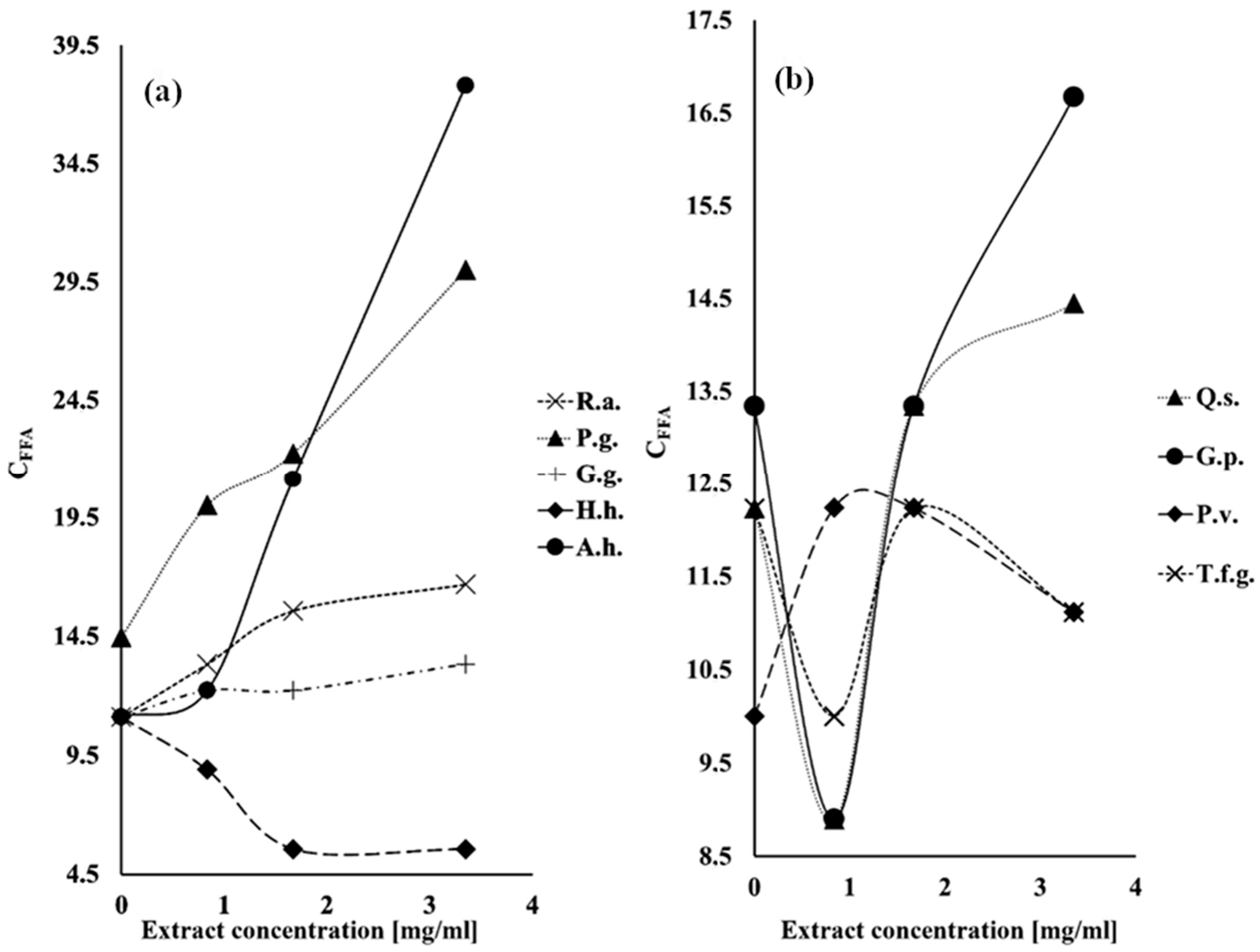
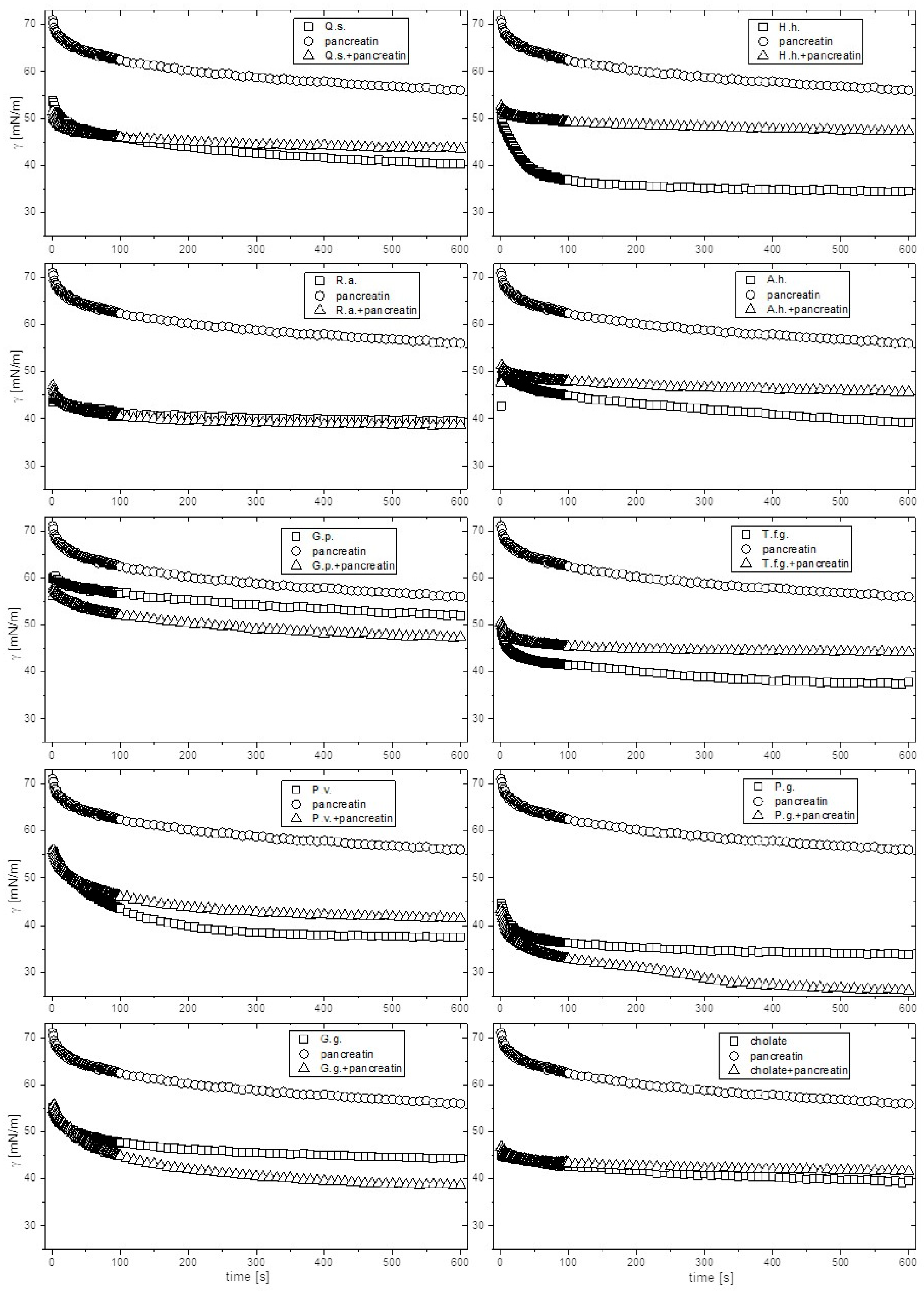
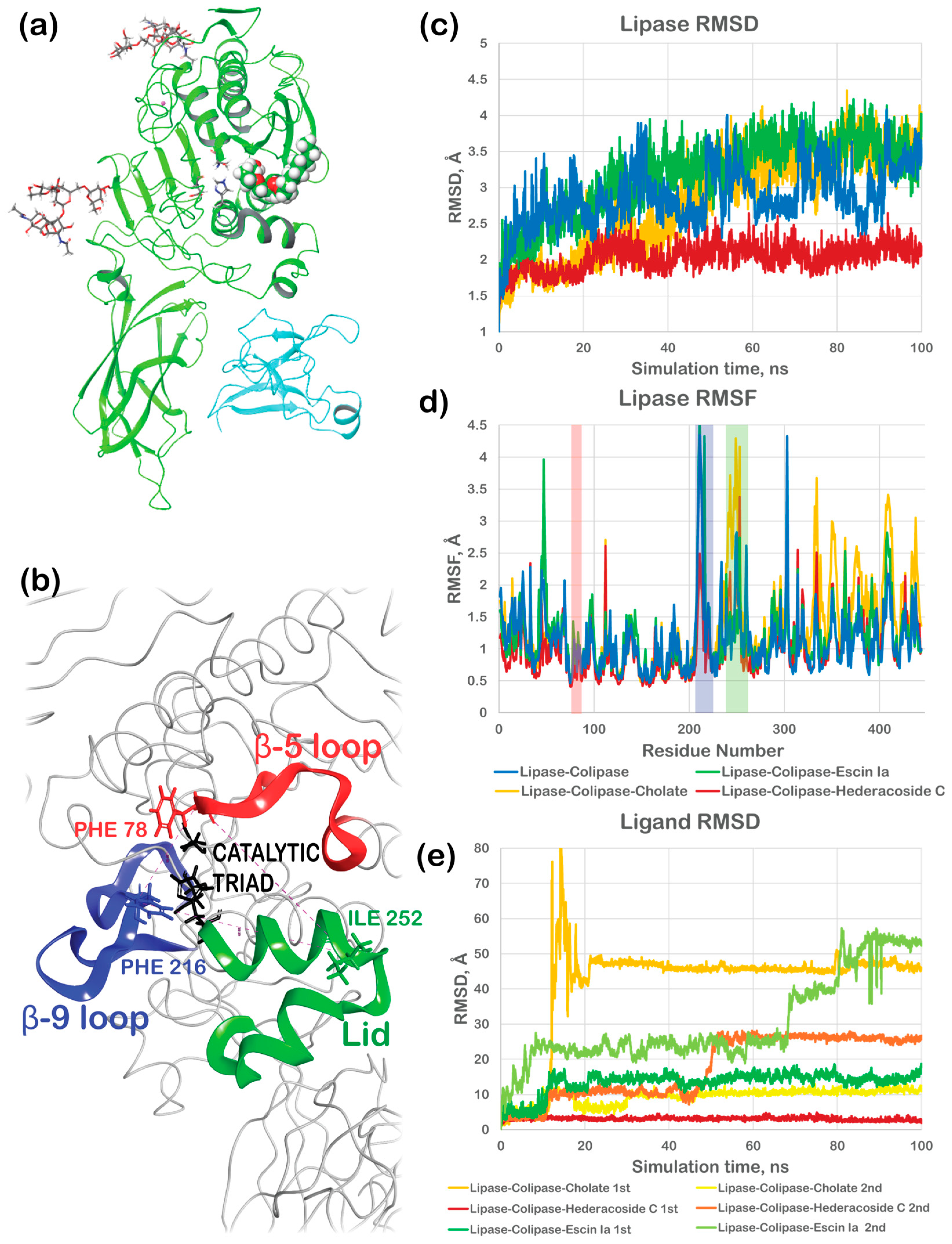
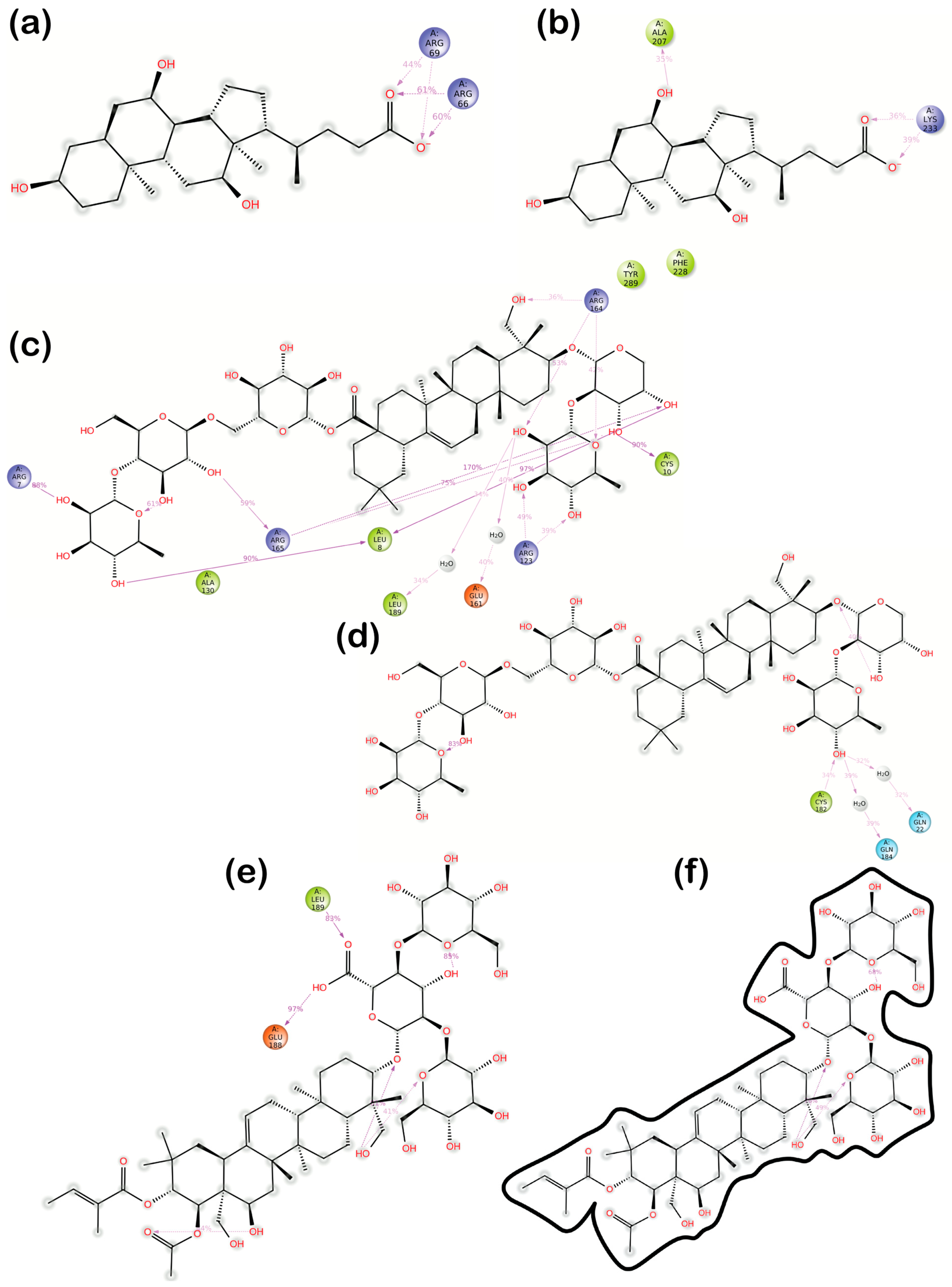
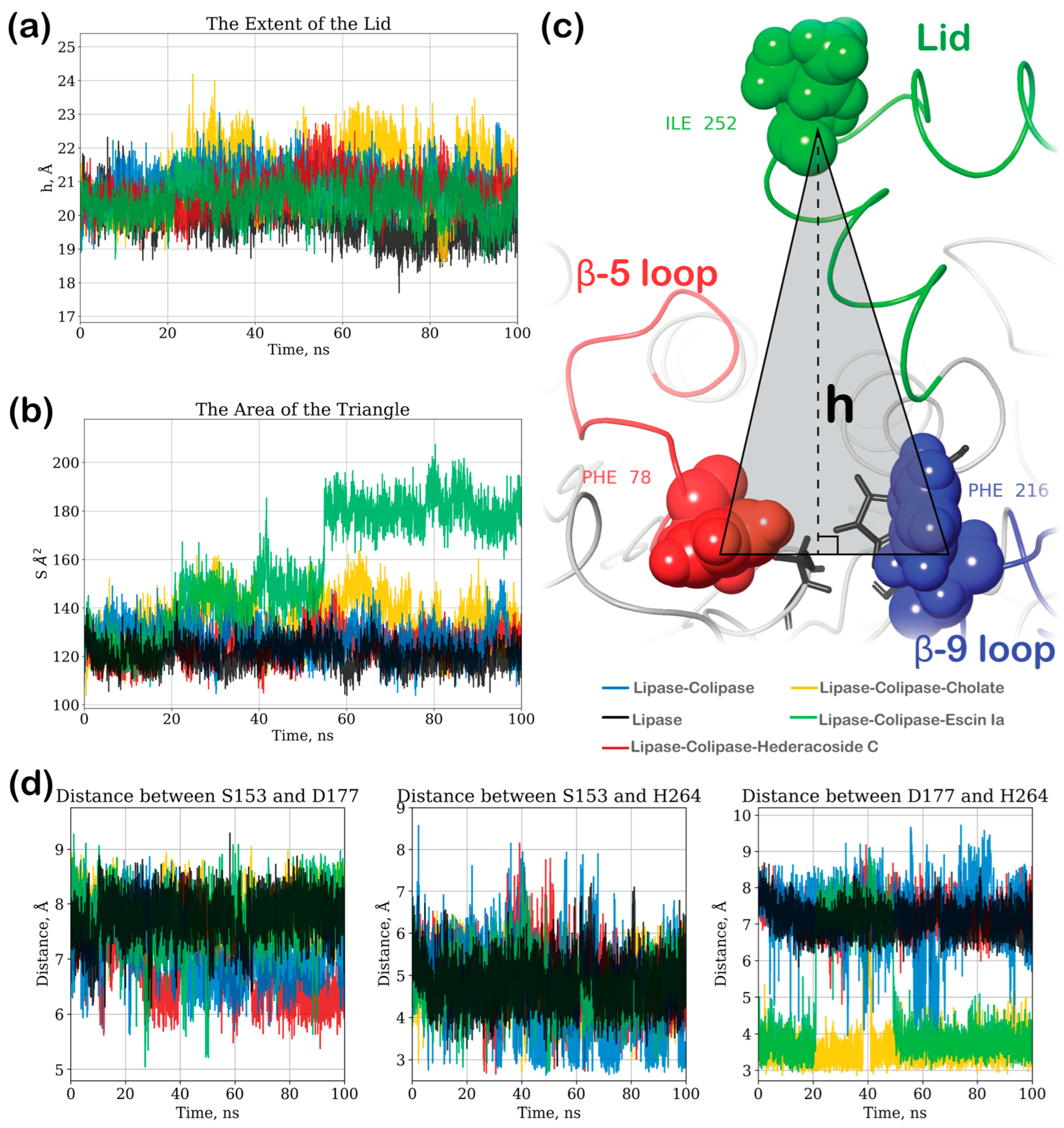
| Extract | RA% ± ME | Effect% ± ME |
|---|---|---|
| R.a. | 150 ± 30 | 50 ± 48 |
| Q.s. | 118 ± 24 | 18 ± 37 |
| G.p. | 125 ± 26 | 25 ± 63 |
| P.g. | 207 ± 29 | 107 ± 49 |
| G.g. | 120 ± 87 | 20 ± 78 |
| P.v. | 111 ± 41 | 11 ± 58 |
| H.h. | 50 ± 42 | −49 ± 49 |
| A.h. | 340 ± 59 | 240 ± 82 |
| T.f.g. | 91 ± 38 | −9 ± 46 |
| Cholate | 1058 ± 30 | 958 ± 81 |
| Extract | GAE ± ME | QE ± ME | Tx [mM] ± ME | Fe2+ [mg/mL] ± ME |
|---|---|---|---|---|
| R.a. | 243 ± 54.5 | 20.6 ± 4.24 | 1.37 ± 0.024 | 5.42 ± 0.192 |
| Q.s. | 116 ± 4 | 20.6 ± 1.32 | 1.28 ± 0.076 | 0.80 ± 0.057 |
| G.p. | 39 ± 1.62 | 4.20 ± 0.25 | 0.35 ± 0.061 | 0.19 ± 0.038 |
| P.g. | 95.4 ± 6.19 | 14.3 ± 0.715 | 1.36 ± 0.033 | 1.07 ± 0.052 |
| G.g. | 155 ± 22.0 | 362 ± 1 | 1.37 ± 0.025 | 2.03 ± 0.086 |
| P.v. | 142 ± 13.7 | 17.3 ± 2.65 | 1.27 ± 0.065 | 0.62 ± 0.048 |
| H.h. | 146 ± 6.20 | 90.0 ± 14.7 | 1.37 ± 0.026 | 1.34 ± 0.101 |
| A.h. | 131 ± 6.56 | 78.7 ± 6.57 | 1.37 ± 0.019 | 0.74 ± 0.066 |
| T.f.g. | 94.2 ± 4.43 | 164 ± 6.95 | 1.30 ± 0.071 | 0.82 ± 0.048 |
Disclaimer/Publisher’s Note: The statements, opinions and data contained in all publications are solely those of the individual author(s) and contributor(s) and not of MDPI and/or the editor(s). MDPI and/or the editor(s) disclaim responsibility for any injury to people or property resulting from any ideas, methods, instructions or products referred to in the content. |
© 2025 by the authors. Licensee MDPI, Basel, Switzerland. This article is an open access article distributed under the terms and conditions of the Creative Commons Attribution (CC BY) license (https://creativecommons.org/licenses/by/4.0/).
Share and Cite
Sroka, Z.; Kapusta, K.; Suchańska, K.; Kołodziejczyk, W.; Żbikowska, B.; Gamian, A.; Strzelczyk, K.; Gleńsk, M.; Wojciechowski, K. Antiradical and Antioxidant Activity and Stimulation of Pancreatic Lipase by Extracts Obtained from Saponin-Rich Raw Materials: Experimental and In Silico Study. Int. J. Mol. Sci. 2025, 26, 10254. https://doi.org/10.3390/ijms262110254
Sroka Z, Kapusta K, Suchańska K, Kołodziejczyk W, Żbikowska B, Gamian A, Strzelczyk K, Gleńsk M, Wojciechowski K. Antiradical and Antioxidant Activity and Stimulation of Pancreatic Lipase by Extracts Obtained from Saponin-Rich Raw Materials: Experimental and In Silico Study. International Journal of Molecular Sciences. 2025; 26(21):10254. https://doi.org/10.3390/ijms262110254
Chicago/Turabian StyleSroka, Zbigniew, Karina Kapusta, Klaudia Suchańska, Wojciech Kołodziejczyk, Beata Żbikowska, Andrzej Gamian, Kacper Strzelczyk, Michał Gleńsk, and Kamil Wojciechowski. 2025. "Antiradical and Antioxidant Activity and Stimulation of Pancreatic Lipase by Extracts Obtained from Saponin-Rich Raw Materials: Experimental and In Silico Study" International Journal of Molecular Sciences 26, no. 21: 10254. https://doi.org/10.3390/ijms262110254
APA StyleSroka, Z., Kapusta, K., Suchańska, K., Kołodziejczyk, W., Żbikowska, B., Gamian, A., Strzelczyk, K., Gleńsk, M., & Wojciechowski, K. (2025). Antiradical and Antioxidant Activity and Stimulation of Pancreatic Lipase by Extracts Obtained from Saponin-Rich Raw Materials: Experimental and In Silico Study. International Journal of Molecular Sciences, 26(21), 10254. https://doi.org/10.3390/ijms262110254







